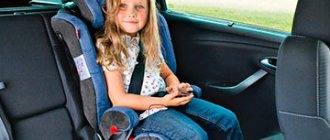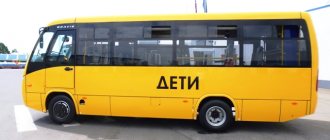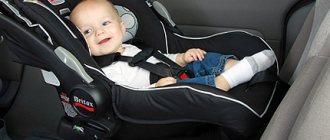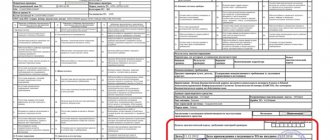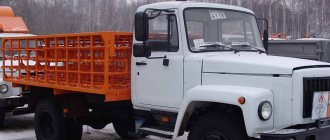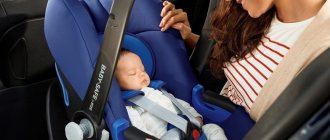Rules for transporting children in a car in 2021
How to choose the right car seat?
When choosing a car seat, it is important to focus on the age, as well as the physical parameters of the child who will be transported in it. The selected model must also have special mountings for front installation. In addition, before purchasing a car seat, it is recommended to familiarize yourself with the crash test results of pre-selected models.
What to do if a traffic police officer wants to fine you for transporting a child in a car seat in the front seat?
There are situations when traffic police inspectors fine drivers for transporting a child in front, even in a car seat. As a rule, they rely on ignorance of the laws or talk about the non-compliance of the child restraint system with the parameters of the passenger. In such situations, the driver must refer to clause 22.9 of the traffic rules, and also prove that the child restraint system is fully suitable for the child’s weight category.
Today, the law allows children to be transported in the seat located in the front of the car, provided that it is equipped with a special restraint system, which is what a car seat is. Otherwise, the driver will be punished in accordance with current legislation.
There is no need to disable the side airbag - it does not threaten the safety of the small passenger, but, on the contrary, provides him with additional protection. The main thing is that the child does not lean against the door or glass. Make sure that the baby always sits correctly in the car seat, in particular, the head should rest only on the headrest of the car seat.
After 12 years, children can already be transported without using a car seat, but only if the child is taller than 1.5 meters. If his height does not exceed the specified mark, then it is worth using holding devices. Also, from the age of 12, a child can ride in the front seat without special restraints , fastened only with adult seat belts.
For most parents, nothing changes - the rules for transporting a child in a family car or in a taxi in 2021 remain the same. The changes affect the transportation of groups of children by bus - the rules are really becoming stricter for organizers of such trips.
Parents should be aware of these changes, at least briefly, just to monitor the safety of their children when sending them to children's camps, on school excursions, etc.
If a child is traveling in a car with his parents, in 2021 the classic transportation rules apply. The minor must be in a car seat that is suitable for his height and age. Transporting children under 12 years of age in the front seat of a car is not prohibited if special restraints are used. Parents must select the appropriate device themselves.
Is transportation allowed in any vehicles?
Modern parents are ready to travel long distances from the first days after discharge. Today, service in roadside hotels, trains and planes only contributes to this. Almost every gas station located along the highways has a full-fledged mother and child room where you can carry out hygiene procedures, change clothes and swaddle the baby.
Newborn head size
The train is convenient when the whole family buys a compartment and travels without others. When purchasing a ticket, it is important to consider whether the carriage has air conditioning when the trip is planned in the summer. For medical reasons, there are no age restrictions for traveling by car or train. You can travel with your newborn on this transport without fear for his condition.
Airplanes are contraindicated for children under 14 days of age. The danger lies in the imperfection of the child’s body. The rapidly changing pressure during takeoff and landing can be very dangerous for a newborn. It is safest to fly after your baby is one month old.
Attention! The danger of traveling by public transport also lies in the fact that a newborn ends up in a small enclosed space with strangers who can be carriers of contagious infectious diseases for which the baby has not yet been vaccinated.
Changes to the rules for transporting children in a car in questions and answers
The traffic rules do not provide for a minimum age from which children can be transported in the front seat, however, if the child is under 12 years old, then a special child car seat is required . Thus, in legal terms, children can be transported in the front seat from the moment they are born.
New as of July 12, 2017: Up to 7 years of age, a child must be transported in a car seat not only in the front seat, but also in the back seat. From 7 to 12 years of age, a child can be transported in the back seat either in a car seat or using standard seat belts.
Minor passengers are allowed to be transported in cars and truck cabins, subject to certain rules. It is prohibited to transport children under 12 years of age on the back seat of a scooter or motorcycle. Now they are allowed to be transported in passenger cars if the seat is equipped with a special seat or cradle. The booster and triangular configuration adapter are not suitable for this.
Recommendations for the correct transportation of infants in vehicles are prescribed in the Russian Federation Traffic Regulations, in paragraph 22.9. The latest version states that it is not allowed to transport newborns without restraints. There are no detailed explanations, but this implies the use of a cradle, LDC, stroller, car seat, taking into account the age and weight of the passenger.
If the question arises whether it is possible to transport a small child in your arms, it is worth reading clause 22.9 of the Russian Traffic Regulations, as amended. The rules here are the same as for children under one year of age, provided that there is a device that matches the weight and age of the baby. Passengers under 7 years of age and older are allowed to travel if standard seat belts or a system with the Isofix mark -1 are provided.
When can you carry a child in the back without a seat?
Parents can carry children of any age in the back seat, but child restraints must be used for all children under 12 years of age. After reaching this age, you can use the standard seat belts found in every car.
Parents should focus not only on the age of their child, but also on his weight and height. For some 6-year-olds, choosing the best car seat is simply not possible, so they can only use a standard car seat belt and booster seat.
Is it possible to transport a child in the front seat?
Without special devices, transporting children in a car in the front seat is allowed from 12 years of age. The child's height must be at least 1.5 meters. For safety, it is necessary to use standard securing straps, adjusting them accordingly.
The table shows the official standards for children's car safety devices, in accordance with the law and the requirements of the State Traffic Safety Inspectorate.
Law enforcement officials can impose fines not only for the absence of a child seat, but also for improper installation of the accessory, or violation of the norms for accompanying children at night. The seat is not allowed to be installed upside down. This contributes to serious injury or death as a result of an accident or emergency stop.
- children under 7 years of age must be transported using a car seat appropriate for their height and weight (no boosters or other “devices”, only a seat);
- from 7 to 11 years old, a child can now move in a car without a seat - simply by being secured using a standard seat belt, but not in front;
- if a child under twelve years of age is in the front seat during a trip, then a child car seat must be used;
- It is prohibited to leave children (under seven years of age) unattended by an adult in the vehicle.
The fine for transporting a child without a car seat has not changed. It is 3 thousand rubles. For leaving a child under 7 years of age alone in a car, the driver is subject to a fine of 500 rubles (but a warning is also provided).
Keep in mind - in cases where law enforcement agencies find a child locked alone in a car, they can initiate a criminal case under the article “Leaving in danger”, which entails criminal liability for the driver, penalties of about 80 thousand rubles (even imprisonment for a term is possible up to 1 year). In addition, the guardianship and trusteeship authorities will be interested in you. Particularly zealous police may see such an offense even when you go to pay for fuel at a gas station.
How to transport a baby from the maternity hospital in a car
Every responsible parent should think about how to transport a newborn in a car even before he is born. The smartest thing to do is to choose a suitable car seat together with your wife, so that later there will be no disputes about the color or pattern on the product.
Important! The newborn cannot take a sitting position. Until 7 months, it is not safe for a baby to keep his back in an upright position for a long time. Therefore, from birth to 7-8 months, the child can only be transported in a lying position.
To ensure safety and eliminate vertical load on the spine, babies up to 7-8 months old should be transported in a shell cradle. Its design is designed in such a way that the child sits reclining in it, securely secured with seat belts.
Rules for transporting children in a car
- Before the 2021 changes to the traffic rules, children under 12 years of age could travel not only in a car seat, but also in any device that raised the child to such a level that the seat belt was not on his neck or collarbone.
- To transport a child in the seat next to the driver, you must use a car seat. No alternatives can be used.
- Children aged 7 to 11 years can be transported in the rear seat simply by being fastened with a regular seat belt without special devices.
- A child under 7 years old cannot be in a car without an adult for even a couple of minutes.
Note: A child seat or other restraint device must meet the following requirements:
- when choosing a device, take into account the weight and height of the child (chairs and boosters have a certain gradation);
- avoid low-quality, frankly cheap products - after all, your baby’s life is at stake;
- securely fasten the chair, it is not enough just to install it on the seat;
- It is necessary to turn off the airbag if a child is carried in the front seat; many cars have a weight sensor that turns off the front passenger airbag up to a certain value. Otherwise, its operation may seriously injure the child in an accident. In some cars, the airbag can be turned off manually. Don't forget to do this.
- the safest place to install a child seat is the center of the rear row of seats;
- The belt you use to secure your child should not go over his neck or collarbone.
And for children over 7 but under 12 years old there are still some restrictions. They can also sit in the back row simply by fastening with regular seat belts. But simply transporting them in the front seat is still prohibited. If a child rides in the front, he must be in a car seat. In this case, the driver needs to turn off the passenger airbag: in the event of an accident, it will only injure the child.
All children under 7 years old will only have to ride in a car in a car seat. From a legal point of view, they cannot be fastened with regular belts, even if they are taller than 1.5 meters.
The location of the seat does not matter: the child seat must be in both the front and back rows. And it should be selected taking into account the height and weight of the child.
No child seat is suitable for infants, but you cannot hold them in your hands during the trip. Both options are extremely unsafe. The chair will not work because the baby’s muscles and spine are not yet fully developed: in a sitting position, he can get injured even during sudden braking. Simply holding him in your arms is also dangerous: during a collision, an adult simply will not be able to hold him.
For infants, special infant carriers are sold in which they will remain in a horizontal position at all times. This reduces the risk of injury during braking and accidents. This car seat can take up two seats. But some models can be installed in the front seat; the law does not prohibit this.
Types of restraint devices
There are several types of restraint systems designed for transporting children in a car. The main criterion by which they differ from each other is the age and weight of the child.
So, in total there are about 6 types of such devices. This includes the following:
Car seat (group 0) – designed for transporting babies aged 0 to 6 months. This system looks like a cradle from a regular stroller. Children are transported in it completely in a lying position. At the same time, it is excellent for weak children with problems with the spine, breathing, etc.
From a safety point of view, a car seat is significantly inferior to a car seat.
Car seat (group 0+) – used for older children (up to 1 year of age). However, it can also carry newborns.
In a group 0+ car seat, the child is in a reclining position. At the same time, the tilt angle is 30-45 degrees, which ensures a comfortable ride and a high level of safety.
A holding device of this category has one very important advantage. In the event of an impact, the chair holds the child's head, which avoids injury to fragile cervical vertebrae.
Car seat (group I) – designed for a child from 9 months to 4 years (9-18 kg). Suitable for children who can already sit.
Such chairs are equipped with a five-point harness or a special holding table. At the same time, a slight inclination is maintained so that the child can sleep comfortably.
Car seat (group II) – suitable for children whose age ranges from 3-7 years with a weight of 15-25 kg. This restraint system is designed for long trips.
In most cases, a Group II car seat is sold combined with other seats intended for older children.
Car seat (group II-III) – designed for ages from 3 to 12 years. It does not provide five-point fastenings, so the child is secured in the seat using a regular seat belt. The car seat of this group has a slight tilt.
Booster (group III) is a solid structure that looks like a seat without a backrest. This restraint system is equipped with armrests, as well as guides for seat belts.
Boosters are significantly inferior in safety to a car seat due to the lack of side protection.
In addition to the above, today there are also retention systems on sale that combine several groups at once (For example, from 0 months to 4 years, from 1 year to 12 years, etc.).
Features of installing car seats of various groups on the front seat
It is important not only to purchase a car seat for your child, but also to install it correctly in the car. Different groups of restraint systems may be attached with some differences.
The installation of child seats in a car must take into account the following features:
- Car seat (0) – in most cases it takes up a lot of space, so installing it on the front seat will not work. It is located in the rear seats in the cabin. The direction must be perpendicular to the movement.
- Car seat (0+) – can be installed in both the rear and front seats. In this case, it must be placed against the direction of travel.
- Car seat (I, II, III) and booster – can be attached to any of the seats in the car, including the front one. However, such restraint systems can only be installed in the direction of travel.
When installing a car seat in the front seat of a car, you should remember to turn off the airbag. In the event of an impact, it opens at a speed of 300 km/h, which can cause significant harm to the baby’s health, including death.
New rules for transporting children in cars in 2021
The law does not establish any restrictions on the installation location of a child seat. The only condition when transporting a child in a child seat in the front seat is the absence or deactivation of an airbag.
As for safety, the central seat in the back row is considered the most secure. This is where it is best to install a child seat in order to protect the child as much as possible in case of accidents.
- Car loans
- All about OSAGO
- All about CASCO
- Car insurance
- Car taxes
- Road accident - what to do?
- All about carsharing
- Fines
- Registration actions
- Communication with the traffic police
- To help drivers
- Calculate transport tax
- Calculate OSAGO
- Calculate CASCO
- Calculate car loan
- Calculate fuel consumption
- Car customs clearance calculator
| Violation | Article of the Code of Administrative Offenses of the Russian Federation | Punishment |
| Absence of identification signs “Transportation of children” or “Speed limit” on a bus transporting children | Part 1 Art. 12.5 Code of Administrative Offenses of the Russian Federation | warning or 500 rub. fine |
| “Children in the car” sticker obstructs the driver’s view | Part 1 Art. 12.5 Code of Administrative Offenses of the Russian Federation | warning or 500 rub. fine |
| Violation of the rules for transporting children (carriage of a child under 12 years old in the front seat of a car without a car seat, in the back seat of a motorcycle, etc.) | Part 3 Art. 12.23 Code of Administrative Offenses | Fine 3000 rubles. — for the driver; 25,000 rub. - for officials; 100,000 rub. - for legal entities. |
| Violation of the rules for the organized transportation of children from 23.00 to 6.00. | Part 5 Art. 12.23 Code of Administrative Offenses of the Russian Federation | for the driver - 5000 rubles. fine or deprivation of driving license for 4 - 6 months; for officials - 50,000 rubles; for legal entities - 200,000 rubles. |
| Violation of the requirements for the organized transportation of children to buses, drivers or documents | Part 4 Art. 12.23 Code of Administrative Offenses of the Russian Federation | Fine 3000 rubles. — for the driver; 25,000 rub. - for officials; 100,000 rub. - for legal entities. |
| Violation of other requirements for organized transportation of children | part 6 art. 12.23 Code of Administrative Offenses of the Russian Federation | Fine 25,000 rubles. - for officials; 100,000 rub. - for legal entities. |
Will there be a fine for a child in a sling or in his arms in the front seat of a car?
The transportation rules clearly state that a separate restraint device is required for the child, so transportation in a sling or in arms is prohibited. This should be taken into account when choosing an option for transporting a child. This ban applies not only to the front seat, but also to the rear seat.
A sling is not a securing device for transportation; it simply helps a mother hold her baby, so this transportation option is also prohibited. In the event of an accident, this will result in serious injury, and in a collision with traffic police officers - a fine.
Important ! Even when traveling short distances, you should not neglect the safety of your child, because emergency situations always happen unexpectedly, no one can predict them in advance. You can't risk safety for the sake of your own comfort, so slings and other similar solutions are only good for outdoor use, which is what they were originally intended for.
Is it possible to carry a child in the front seat in a car seat - rules in 2021?
But even a well-installed chair is powerless against impacts with the so-called 25% overlap. Such accidents occur when drivers try to avoid a head-on collision and cars hit each other at an angle. Often it is the right nose of the car that gets hit. The vector of kinetic energy is directed past the side members and crushed zones; it penetrates into the load-bearing frame of the cabin and distorts it.
When tested by the American Insurance Institute IIHS (Insurance Institute for Highway Safety), such an impact crushed the body pillar into the cabin, even in models famous for their reliability. At the same time, the passenger door was torn off its hinges and it was thrown around like a guillotine. A child in front is at much greater risk than an adult passenger, since it is more difficult to hold a cradle or child seat in standard three-point belts than an adult. There is a risk that the child and the restraint device will slip out of the mangled body through the torn door.
Therefore, despite the absence in existing legislation of a direct ban on transporting children in front, doing this is extremely dangerous (either in the direction of travel or against it). Therefore, it is best to install the seat on the rear sofa in the standard ISOFIX connectors. And the most correct thing would be to teach your child to ride in the back from the very first acquaintance with the car. Then he will never ask to move forward.
The regulatory act of traffic rules, paragraph 22.9, sets out the rules that must be followed when a child is in the car, in the front or rear passenger seat.
The following standards must be observed:
- up to seven years - travel in the back and front seats and with full fixation using a cradle or car seat;
- being in a seat and secured with belts is mandatory, even for short trips;
- for children from 7 years to 12 years, and large children who do not fit in a seat can be transported without a seat only in the rear seats of the car;
- The cradle or chair is selected according to age and weight.
For violation of these rules, an administrative fine is imposed for a child without a chair - 3,000 rubles in all regions, in accordance with Article 12.23 of the Administrative Code.
For leaving a child under 7 years old in the car, the penalty amount is 2,500 rubles for residents of Moscow and St. Petersburg, and 500 rubles for other regions (Clause 1.Article 12.19 of the Administrative Code).
The fine for not having a child seat varies depending on who committed the offense:
| Responsible person | Amount of fine in rubles |
| Driver (Parents, relatives) | 3 000 |
| Officials – educators, teachers, taxi drivers | 25 000 |
| Legal entities – school, taxi company | 100 000 |
It is possible to pay the fine with a 50% discount within 20 days from the date of delivery of the decision to the citizen.
Most often, difficulties with the law on child seats arise in large families. One car can comfortably accommodate two, rarely three, seats, but without them all four or even five children could fit in the back seat.
Another drawback is the imposition of fines on taxi drivers. Sometimes parents deliberately do not warn that there will be a child in the cabin, so as not to increase the cost of the trip. When an inspector stops a car, the blame falls on the taxi driver. In extreme cases, the fine for parents will be 3,000 rubles, and for the driver – 25,000.
Types of car seats for children on the Russian market:
| Child's age | Restraint type | Weight in kg. | Group (class) car seats |
| from birth to 1 year | Carrying or “cradle”. They are installed in the car in one of two positions: horizontal, in which the child can sleep in the car, vertical, in which the baby is held using a special belt. | to 10 | 0 |
| up to 1.5 years. Can be used for children from the first day of life. | Armchair. The child in it is in a “reclining” state. The device can be positioned either with your back or facing the direction of travel. | up to 13 | 0+ |
| from 1 year to 4 years | Armchair. Installation can only be done in the direction of travel of the vehicle. The child is secured using durable, five-point harnesses. | 9-18 | 1 |
| from 3 to 7 years | Armchair. Standard seat belt. The chair has an adjustable backrest that can be adjusted to the height of the child. | 15-25 | 2 |
| from 7 to 12 years | Seat without backrest. The child is held in place by an additional seat belt. | up to 36 | 3 |
Each type of seat is used only for children of a certain age. Some car seats, for example, categories 0 and 0+, are adjustable depending on the child’s height and weight, but from 1.5 years old it is necessary to purchase a larger seat.
When purchasing a child seat for your car, there are a few things to consider:
- Type of belt fastening. There are two types of fastenings: standard and improved - ISOFIX. Both options are suitable for passing a traffic police check, but the ISOFIX system is more reliable in the event of an accident.
- Seat belts on the seat. Small children must be secured in the bassinet. Special built-in belts are designed for this - three- or five-point. Fixing with a safety table is also possible. The best option is a five-point harness.
- Chair frame. The most durable and reliable is the aluminum frame, as opposed to plastic.
- You should choose those models that are equipped with a durable, large headrest and sides.
- Preference should be given to covers made of cotton fabric, as they are better suited to the baby's skin and do not irritate it.
- By car and driver
- By resolution number
There is no clause in the traffic rules that would say at what age a child can ride in the front seat of a car. In fact, it turns out that from birth, but only in a special restraint device. A car seat is required until the child reaches the age of 12 years.
This year, the term “other restraint devices” no longer appears in traffic rules. It is no longer possible to fasten a child with belts like FEST. According to the new rules, children can only be transported in seats or booster seats. But auto experts say booster seats do not keep children safe, so parents are increasingly refusing to buy them.
The question of whether it is allowed to transport children in the front seat of a car is not at all legitimate. It is not prohibited. The rules don't say anything about this. Everything said in them relates to the age of children. Also, height and weight are reflected in the document. Babies can be safely placed in the front. This is convenient for young parents when transporting babies without the presence of any other adults in the car besides the driver. The baby is in front of your eyes, and you don’t have to worry about him along the way. Rules for transporting children in the front seat require:
Transporting children in the front seat of a car according to traffic regulations from 2021 will complicate the relationship between fathers and children. The main concern for children, of course, lies in the responsibility of parents. It happens that wishing their child well, with the best intentions, not wanting to restrict freedom even when moving in a car, parents expose their child to unnecessary danger. The recommended seats for transporting children by car do not necessarily constrain or cause discomfort to children. If you approach the selection of a seat with imagination, its installation, the choice of a comfortable and, most importantly, safe place and occupy it correctly, then nothing but peace and security will be disturbed during the journey. The statistics of the death of minors in road accidents is such that it is safer to follow the rules for transporting children in a car.
Legislation regulating traffic rules pays special attention to the transportation of children in a car. From January 1, 2021, significant amendments have been made to the relevant documents regarding the safety of young passengers. Let's take a closer look at them.
What is meant by the term “special restraint device”? It can be either a car seat corresponding to the child’s age and weight category, or a booster. A child car seat for children under 7 years of age must be equipped with seat belts. Older children can be secured with standard seat belts and additionally use a booster. When placing a small passenger in the front seat, special securing devices are required.
22.9. Transportation of children under the age of 7 years in a car and a truck cab that is designed with seat belts or seat belts and an ISOFIX* child restraint system must be carried out using child restraint systems (devices) that are appropriate for the weight and height of the child. The name of the ISOFIX child restraint system is given in accordance with the Technical Regulations of the Customs Union TR RS 018/2021 “On the safety of wheeled vehicles”. Transportation of children aged 7 to 11 years (inclusive) in a passenger car and truck cab, which are designed with seat belts or seat belts and an ISOFIX child restraint system, must be carried out using child restraint systems (devices) that are appropriate for the weight and height of the child , or using seat belts, and in the front seat of a car - only with the use of child restraint systems (devices) corresponding to the weight and height of the child. The installation of child restraint systems (devices) in a passenger car and the cabin of a truck and the placement of children in them must be carried out in accordance with the operating instructions for the specified systems (devices). It is prohibited to transport children under the age of 12 on the back seat of a motorcycle.
If the inspector still demands evidence and tells you that in any case he will issue a fine for an unbelted child, and then you have to prove whether he has reached 7 years of age or not, then in this case he is wrong. The driver is not obliged to prove his innocence, and any doubts about the innocence of the driver involved should be interpreted in favor of this driver (clauses 3 and 4 of Article 1.5 of the Administrative Code).
Previously, paragraph 22.9 of the Road Traffic Regulations contained a clause that other means and devices could be used to fasten a child with seat belts. Now it has been excluded, and this paragraph is set out in a new edition. The main requirement for such products is formulated as follows: they must correspond to the weight and age of the child. In this case, the rules refer motorists to the manufacturers' instructions and regulations.
In 2021, it is allowed to carry a child in a car from the moment of birth; the traffic rules do not contain any prohibitions regarding age. In accordance with clause 22.9 of the Rules, in order to transport children, the design of the car must provide for the presence of seat belts, which can be used either separately or in conjunction with the ISOFIX restraint system.
22.9. Transportation of children under the age of 7 years in a car and a truck cab that is designed with seat belts or seat belts and an ISOFIX* child restraint system must be carried out using child restraint systems (devices) that are appropriate for the weight and height of the child.
The rule states that while driving, the child must be in a special car seat or restraint device that is appropriate for the age and weight of the passenger. You can't buy a chair to grow into. But you can use universal types of chairs that are designed for children from birth to 3 years old with a reclining back.
Transporting children in a truck and a car differs in only one point - children can be transported in the front seat of a car without using a car seat or other means only when they reach 12 years of age, while in the cab of a truck this can be done from the age of 7. The law states that the age group 7–11 years old can be in the cab of a truck either in a restraint or simply wearing a seat belt . If for any reason there are no seat belts, then transporting children is permitted only with the help of a restraint device.
Not all trucks can accommodate child restraints using seat belts. In this case, you should choose a device with a different fastening system.
For incorrectly transporting a child in the front seat, a fine is imposed in accordance with the Code of Administrative Offences. There are two possible punishment options:
- if a child is without a restraint seat when, according to traffic regulations, he must be in one, then the fine is 3 thousand rubles;
- If a child who no longer needs a seat is not wearing a seat belt, the driver will pay a fine of 1 thousand rubles.
Placing the youngest passengers in the front has both positive and negative aspects.
The advantages include the following:
- babies like to look out the front window, they are distracted by looking at the world around them, and they usually behave calmer in the front seat;
- if there are no other adults in the car, then it is easier for the driver to observe the baby and react to his actions when he is nearby;
- when the chair is attached to the front, the child usually gets sick less;
- Not all cars can accommodate 3 car seats in the rear seats, so when transporting three children at once, one will most likely have to be seated in the front.
This solution also has disadvantages:
- the most important disadvantage is that the front seat next to the driver is the most dangerous place in the entire car; it is the seat that most often suffers during accidents;
- a restless baby can reach the car controls, open a window or door, which, in turn, can lead to an accident;
- sometimes a child car seat can block the driver’s view in the rear view mirror;
- with active interaction with a child, the driver may be distracted from the situation on the road, and this is fraught with a traffic accident;
- in some cases it is necessary to turn the airbag off and on - not in all cars this can be done independently.
Each parent decides for himself how to transport his child, taking into account all the requirements of traffic rules. But before you seat your baby forward, you should weigh all the pros and cons.
The installation pattern of a car seat depends on its group. All child restraint devices can be divided into several groups according to the weight of the children for whom the product is designed:
- 0 - from 0 to 10 kg (from birth to six months);
- 0+ – from 0 to 13 kg (approximately up to a year);
- 1 - from 9 to 18 kg (on average from 1 to 4 years);
- 2 - from 15 to 25 kg (from 3 to 7 years);
- 3 - from 22 to 36 kg (6–12 years).
Often, categories of car seats are combined - 0/1, 1/2/3, 2/3, which allows you to extend their service life.
Group 0 and 0+ chairs are only allowed to be installed in the rear facing direction of the vehicle - this is due to the baby’s weak neck muscles. Some Group 0 chairs cannot be installed from the front due to their design features, so before installation you must carefully read the instructions from the device. If seats in this group are placed in the front seat, the front airbag must be turned off.
Yes, the law does not prohibit transporting children under 12 years old in a special seat in the first seat, but everyone should know how safe it is. Experts who have conducted a lot of different studies unanimously say that it is better to choose a rear seat for transporting small passengers. The fact is that the first seat is not the safest place in the car. Yes, it is the child who needs to be seated in the safest place, he is small, so injuries in an accident can be more serious than in an adult.
If we consider the issue in terms of a safe place, then it is the place behind the driver. If a dangerous situation arises, the driver’s self-preservation instinct will be triggered and he will automatically try to save himself first.
Despite the fact that when stopped by a traffic police officer, a fine for transporting a child in the first seat will not be issued, the inspector may warn the driver that it is better to move the seat to the rear seat. Whether or not to listen to such a recommendation is everyone’s business, but do not forget that it is the driver who is responsible for his passengers.
Airbag and child
The biggest mistake a motorist can make is installing a child seat with the front airbag still active. Such a pillow can seriously injure a child when deployed.
There is a general rule for all passengers who are in the front seat and will be forced to use an airbag. Their height should exceed 140 cm, which is recommended by the manufacturers of such pillows. Otherwise, you may get injured when using them. In this case, the chair cannot save the little passenger from receiving these injuries, because it also reduces the distance between the seat and the pillow.
So, if the child’s height does not reach 140 cm, then it is worth turning off the airbag while transporting him. On some cars the airbag cannot be removed, so be sure to check this before purchasing. On such models, a special sign is installed prohibiting the placement of child seats in the front seat.
Important ! Paragraph 3.2.6 of Section 3.2 of the Traffic Regulations provides for the possibility of transporting a child with a rear-facing seat installed. That is why there is one exception, which implies the possibility of transporting a child with airbags with sensors without turning them off. In this case, there will be information that the seat is installed against the direction of the car and the airbag itself simply will not work. This functionality is available in new car models, because the problem of safely transporting children in the front seat requires innovative solutions.
| Time since collision | That's right - the front seat is moved back | Incorrect - front seat too close to cushion |
| 0 ms | There was a collision - the car critically reduced speed | |
| 35 ms | The pillow has opened and does not reach the child. | The cushion of probability hits the child's face. There is no damage to the skull, no concussion. But there is a risk of a broken nose. |
| 50 ms | The pillow is fully expanded before the child begins to move forward as a result of inertia. | The pillow expanded completely while it was on the child's face, resulting in scratches. |
| 120 ms | The child's pressure on the pillow is maximum. | The child's pressure on the pillow is maximum. |
| Result and critically affected body parts. | ||
What could be the reasons for transporting a child in front?
Many people are interested in the question of why it is worth transporting your child in the front seat if you can safely use one of the rear ones? Nevertheless, life sometimes forces you to choose the front seat as the basic option for transporting a child, especially in such situations:
- a minor child next to his parent will always be under more scrutiny than if this were happening in the back seat;
- the rear seats are dismantled or simply occupied by some kind of cargo, and transporting the child is extremely necessary;
- if the child is sick or needs special care, then it is recommended to carry him in the front seat, especially if the child has certain fears, so in this case it is also recommended to choose the rear seat;
- in some cases, it is allowed to simply keep the child occupied during the trip by giving him a good overview of all surrounding areas, so that he will be simply interested and will not distract the driver during the trip, which will provide her with an additional level of safety.
Disadvantages of transporting a child in the front seat
It is worth saying that it is not for nothing that the front seat next to the driver is called the suicide seat, because it is in this place that you can suffer the most and it accounts for most of the impacts in an accident with other cars, so the question of the safety of such an event, especially with the airbag turned off, is a big question. From a safety point of view, the best option would be to transport children in the middle rear seat with a good child seat securement, because this option is considered the safest place in the entire car for a passenger.
It must be remembered that all the functionality of any modern car is designed for an adult, and not for a child, so this will have to be taken into account and the installation of additional equipment is not a panacea for ensuring the comfort and safety of the baby.
Airbag deactivation
This process can be performed independently or using the services of specialized services. There are models in which the airbag does not turn off at all, as mentioned above. That is why, before purchasing, you should definitely choose an option that has the ability to turn off such a pillow or sensory detection, thanks to which it can not be turned off and the child will not be harmed.
In a situation where it is possible to remove the cushion from the front seat where the child will be, you should definitely do this, because otherwise there is a risk of injury to the child.
How to install a car seat in the front seat: features
Before installing a car seat in a car, you need to consider some features.
- Airbag deactivation . This condition must be complied with. The airbag deployment speed is 300 km/h. Yes, this is only for the benefit of an adult and he can only get away with bruises, but a child may be injured. By the way, there were even cases of death. So don't neglect this rule.
- Check your visibility in the side mirror . The car seat should not obstruct your view. Some models have high backrests, so be sure to check the visibility before you ride.
- Move the front seat as far back as possible . This will allow you to safely position the chair and open up your view.
Penalty for incorrect transportation
The most common punishment is a fine issued to the owner of the car. Its size will depend on the violation made. In most cases, it will be 3,000 rubles in accordance with Part 3 of Article 12.23 of the Code of Administrative Offenses of the Russian Federation. According to this article, the traffic police officer does not have the opportunity to issue a warning, since this violation is quite serious and jeopardizes the safety of the child during the trip.
Important ! You should not use untested options as a device for holding a child in a seat. Before purchasing a new product, you should definitely consult with specialists or check the traffic regulations.
- in a truck
Traffic rules stipulate that a child must be transported in a truck only in the cabin. This is what makes it possible to transport it safely. The truck must also be able to conveniently and safely transport a child, so, like passenger cars, it requires transportation in a special seat and compliance with all other rules that are relevant for a passenger car.
- in the bus
There is a specific ban on transporting children under 7 years old if the trip takes more than 4 hours. The body of such a bus in which children are transported must be yellow. These rules apply to organized trips.
If we talk about public transport, then it is required to comply with clause 5.1 of the traffic rules, according to which passengers are required to wear seat belts. It is worth noting that there are no other restrictions on transportation.
Important ! It is always worth distinguishing the rules for group transportation of children from those provided for their private trips with their parents. The requirements for group transportation of children are much more stringent and have many restrictions.
- on a scooter or moped in front of you
Carrying a child in front of you is only possible if there is a specially equipped place for him. If there is none, then there is a ban on transporting children under 7 years of age on such vehicles. In other cases, it is imperative to ensure that the child being transported has a sufficient level of transportation safety.
Important ! It is worth remembering that it is prohibited to transport children in the back seat of a scooter or moped if they are under 12 years of age. Carrying a child as a rear seat passenger is not recommended at all, because this option is one of the most dangerous. That is why it is worth choosing alternative solutions that can provide a high level of safety, because this type of transport is one of the most dangerous on the road for adults.

